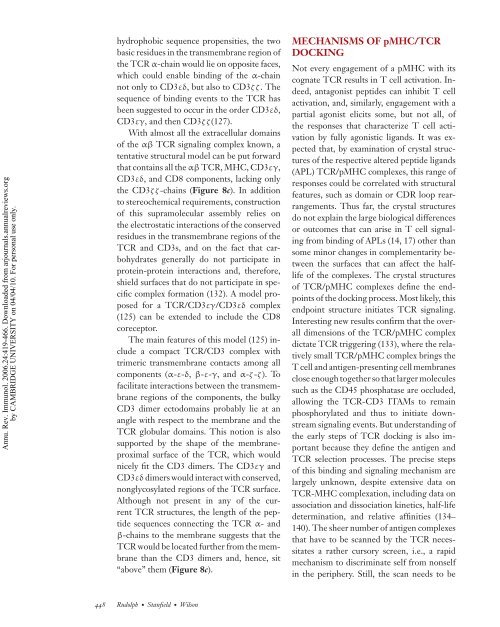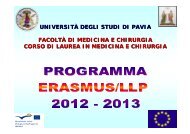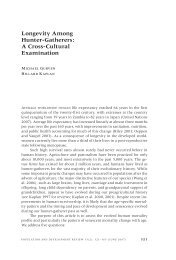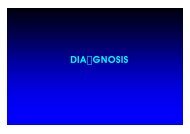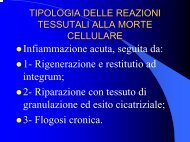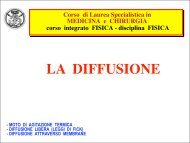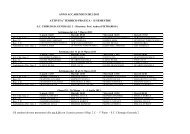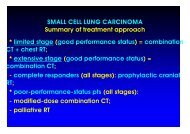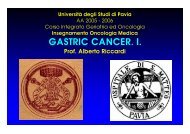Rudolph MG
Rudolph MG
Rudolph MG
You also want an ePaper? Increase the reach of your titles
YUMPU automatically turns print PDFs into web optimized ePapers that Google loves.
Annu. Rev. Immunol. 2006.24:419-466. Downloaded from arjournals.annualreviews.org<br />
by CAMBRIDGE UNIVERSITY on 04/04/10. For personal use only.<br />
hydrophobic sequence propensities, the two<br />
basic residues in the transmembrane region of<br />
the TCR α-chain would lie on opposite faces,<br />
which could enable binding of the α-chain<br />
not only to CD3εδ, but also to CD3ζζ. The<br />
sequence of binding events to the TCR has<br />
been suggested to occur in the order CD3εδ,<br />
CD3εγ, and then CD3ζζ(127).<br />
With almost all the extracellular domains<br />
of the αβ TCR signaling complex known, a<br />
tentative structural model can be put forward<br />
that contains all the αβ TCR, MHC, CD3εγ,<br />
CD3εδ, and CD8 components, lacking only<br />
the CD3ζζ-chains (Figure 8c). In addition<br />
to stereochemical requirements, construction<br />
of this supramolecular assembly relies on<br />
the electrostatic interactions of the conserved<br />
residues in the transmembrane regions of the<br />
TCR and CD3s, and on the fact that carbohydrates<br />
generally do not participate in<br />
protein-protein interactions and, therefore,<br />
shield surfaces that do not participate in specific<br />
complex formation (132). A model proposed<br />
for a TCR/CD3εγ/CD3εδ complex<br />
(125) can be extended to include the CD8<br />
coreceptor.<br />
The main features of this model (125) include<br />
a compact TCR/CD3 complex with<br />
trimeric transmembrane contacts among all<br />
components (α-ε-δ, β-ε-γ, and α-ζ -ζ ). To<br />
facilitate interactions between the transmembrane<br />
regions of the components, the bulky<br />
CD3 dimer ectodomains probably lie at an<br />
angle with respect to the membrane and the<br />
TCR globular domains. This notion is also<br />
supported by the shape of the membraneproximal<br />
surface of the TCR, which would<br />
nicely fit the CD3 dimers. The CD3εγ and<br />
CD3εδ dimers would interact with conserved,<br />
nonglycosylated regions of the TCR surface.<br />
Although not present in any of the current<br />
TCR structures, the length of the peptide<br />
sequences connecting the TCR α- and<br />
β-chains to the membrane suggests that the<br />
TCR would be located further from the membrane<br />
than the CD3 dimers and, hence, sit<br />
“above” them (Figure 8c).<br />
448 <strong>Rudolph</strong>· Stanfield· Wilson<br />
MECHANISMS OF pMHC/TCR<br />
DOCKING<br />
Not every engagement of a pMHC with its<br />
cognate TCR results in T cell activation. Indeed,<br />
antagonist peptides can inhibit T cell<br />
activation, and, similarly, engagement with a<br />
partial agonist elicits some, but not all, of<br />
the responses that characterize T cell activation<br />
by fully agonistic ligands. It was expected<br />
that, by examination of crystal structures<br />
of the respective altered peptide ligands<br />
(APL) TCR/pMHC complexes, this range of<br />
responses could be correlated with structural<br />
features, such as domain or CDR loop rearrangements.<br />
Thus far, the crystal structures<br />
do not explain the large biological differences<br />
or outcomes that can arise in T cell signaling<br />
from binding of APLs (14, 17) other than<br />
some minor changes in complementarity between<br />
the surfaces that can affect the halflife<br />
of the complexes. The crystal structures<br />
of TCR/pMHC complexes define the endpoints<br />
of the docking process. Most likely, this<br />
endpoint structure initiates TCR signaling.<br />
Interesting new results confirm that the overall<br />
dimensions of the TCR/pMHC complex<br />
dictate TCR triggering (133), where the relatively<br />
small TCR/pMHC complex brings the<br />
T cell and antigen-presenting cell membranes<br />
close enough together so that larger molecules<br />
such as the CD45 phosphatase are occluded,<br />
allowing the TCR-CD3 ITAMs to remain<br />
phosphorylated and thus to initiate downstream<br />
signaling events. But understanding of<br />
the early steps of TCR docking is also important<br />
because they define the antigen and<br />
TCR selection processes. The precise steps<br />
of this binding and signaling mechanism are<br />
largely unknown, despite extensive data on<br />
TCR-MHC complexation, including data on<br />
association and dissociation kinetics, half-life<br />
determination, and relative affinities (134–<br />
140). The sheer number of antigen complexes<br />
that have to be scanned by the TCR necessitates<br />
a rather cursory screen, i.e., a rapid<br />
mechanism to discriminate self from nonself<br />
in the periphery. Still, the scan needs to be


